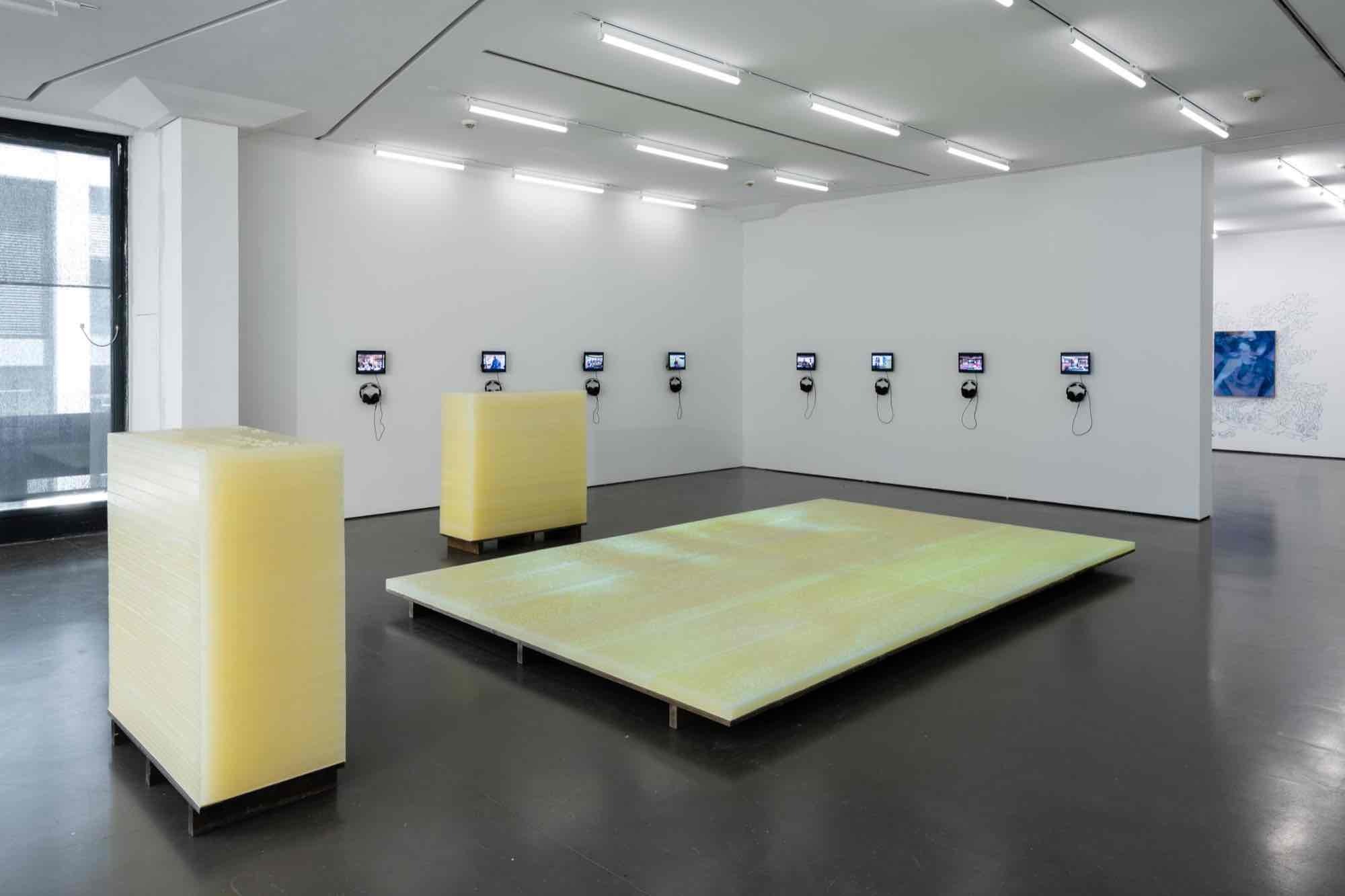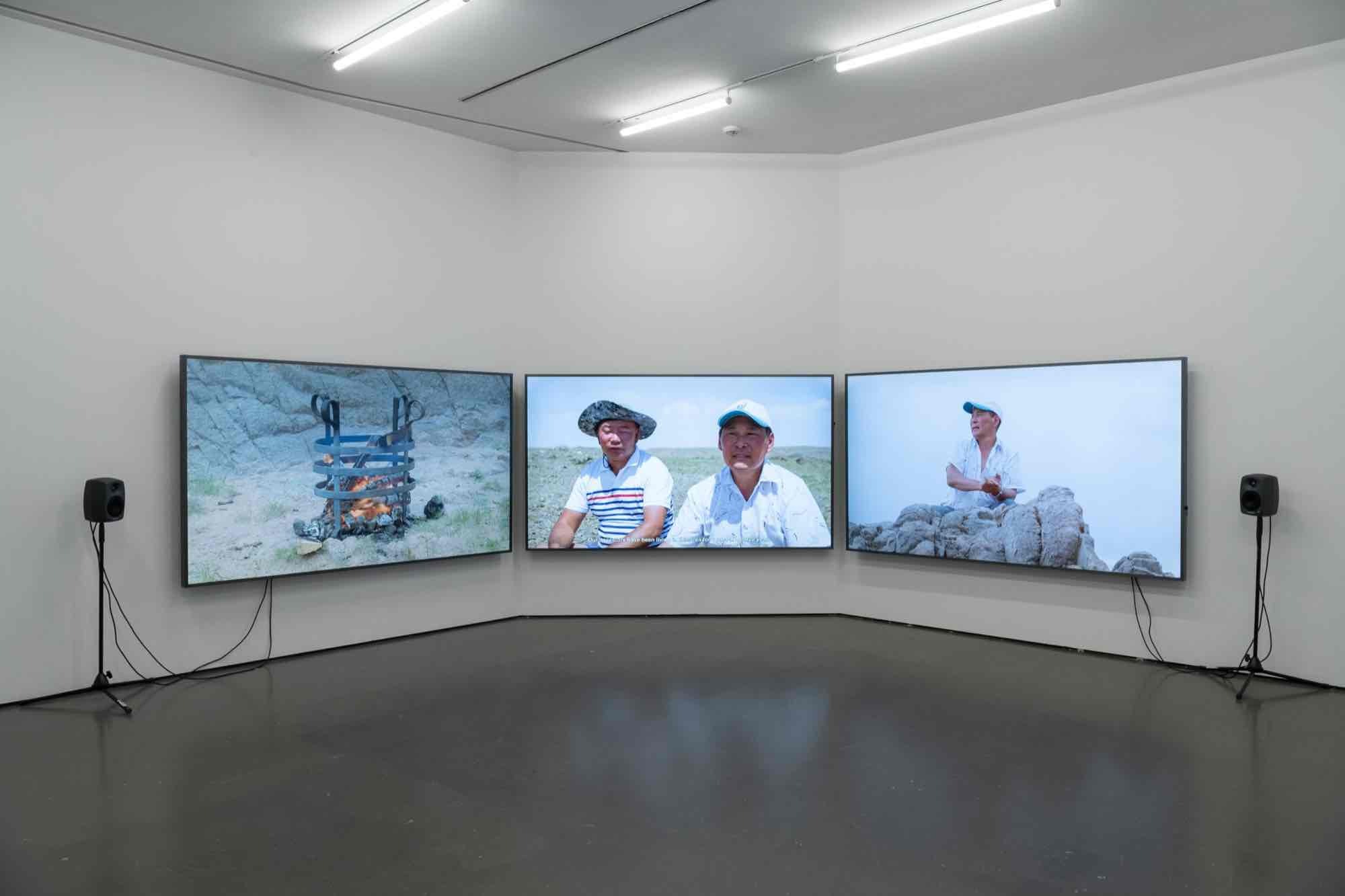Healing the Earth
50 Years of German-Mongolian Friendship
29 Jun - 08 Sep 2024

Installation view, Thomas Stricker, Healing the Earth. 50 Years of German-Mongolian Friendship. Kunsthalle Düsseldorf 2024. Photo: Katja Illner

Installation view, Slavs and Tatars, Healing the Earth. 50 Years of German-Mongolian Friendship. Kunsthalle Düsseldorf 2024. Photo: Katja Illner

Installation view, (f.l.t.r) Claudia Mann, Melike Kara, NOMIN Bold, Healing the Earth. 50 Years of German-Mongolian Friendship. Kunsthalle Düsseldorf 2024. Photo: Katja Illner

Installation view, NOMIN Bold, Healing the Earth. 50 Years of German-Mongolian Friendship. Kunsthalle Düsseldorf 2024. Photo: Katja Illner

NOMIN Bold, Sav Shim, 2022, Healing the Earth. 50 Years of German-Mongolian Friendship. Kunsthalle Düsseldorf 2024. Photo: Katja Illner

Installation view, JAVKHLAN Ariunbold, Ovoo / A twelve years song, 2024
Healing the Earth. 50 Years of German-Mongolian Friendship. Kunsthalle Düsseldorf 2024. Photo: Katja Illner
Healing the Earth. 50 Years of German-Mongolian Friendship. Kunsthalle Düsseldorf 2024. Photo: Katja Illner

Claudia Mann, Headrests, 2019 – 22, Ceramics, clay, bronze, steel, here: 280 × 800 × 30 cm, Dimension variable, photo: Claudia Mann, © VG Bild-Kunst, Bonn 2024
Installation view Kunstverein Leverkusen
Installation view Kunstverein Leverkusen

UNEN Enkh, Big Mom (Venus), 2019, Healing the Earth. 50 Years of German-Mongolian Friendship. Kunsthalle Düsseldorf 2024. Photo: Katja Illner
The extensive group exhibition Healing the Earth is a collaboration between Kunsthalle Düsseldorf, Chinggis Khaan National Museum in Ulaanbaatar and Arts & Media Project Management & Consulting NGO to mark 50 years of diplomatic relations between Germany and Mongolia. The ties between the two nations go back much further than 50 years, however. For example, young Mongolians were sent to study in Germany as far back as 1926. In Mongolia, Germany is still referred to as the country’s “third neighbour”, and more than one per cent of the population speaks German.
Drawing on Joseph Beuys’ early pioneering work, the project Healing the Earth builds a new bridge in the anniversary year of German-Mongolian friendship: between the culture of nomadic peoples (a culture they have practised for millennia and which is vital to their survival) and contemporary art. It is dedicated to the perspectives of different cultures and explores memories from the past. However, it also looks into the future, weaves new threads into an open network of relationships and opens up dialogues between different artistic approaches in order to explore the current state of the planet and possible ways of healing.
Theory and practice and art and politics should not be conceived of as separate systems that have chronically failed to understand each other since the start of the modern era. Instead, they should be understood as a continuum. Art represents the existence of and is witness to the invocation of forces that Western society has gradually forgotten since the advent of the modern era. However, the potential for summoning up of myths and archaic vitality persists; images of human figures and living creatures, homes, tents, mountains, landscapes and the heavens are at once primeval and contemporary.
The works by 18 contemporary artists that will be presented in Düsseldorf and Ulaanbaatar examine ways and means of questioning and challenging the current relationships and circumstances in the world. The web woven by the different works in diverse media may provide an opportunity to distance ourselves from the West’s frequently arrogant attitude and to ask for other, liveable futures in new, unforeseen alliances: What kind of healing for which Earth?
Participating artists:
JAVKHLAN Ariunbold, OCHIRBOLD Ayurzana, BAATARZORIG Batjargal, MUNKHTSETSEG Batmunkh, Joseph Beuys, NOMIN Bold, Mariechen Danz, OTGONBAYAR Dashdorj, UNEN Enkh, GERELKHUU Ganbold, Melike Kara, Claudia Mann, Carmen Schaich, Slavs & Tatars, Thomas Stricker, GAN-ERDENE Tsend, Julian Westermann, TUGULDUR Yondonjamts
Drawing on Joseph Beuys’ early pioneering work, the project Healing the Earth builds a new bridge in the anniversary year of German-Mongolian friendship: between the culture of nomadic peoples (a culture they have practised for millennia and which is vital to their survival) and contemporary art. It is dedicated to the perspectives of different cultures and explores memories from the past. However, it also looks into the future, weaves new threads into an open network of relationships and opens up dialogues between different artistic approaches in order to explore the current state of the planet and possible ways of healing.
Theory and practice and art and politics should not be conceived of as separate systems that have chronically failed to understand each other since the start of the modern era. Instead, they should be understood as a continuum. Art represents the existence of and is witness to the invocation of forces that Western society has gradually forgotten since the advent of the modern era. However, the potential for summoning up of myths and archaic vitality persists; images of human figures and living creatures, homes, tents, mountains, landscapes and the heavens are at once primeval and contemporary.
The works by 18 contemporary artists that will be presented in Düsseldorf and Ulaanbaatar examine ways and means of questioning and challenging the current relationships and circumstances in the world. The web woven by the different works in diverse media may provide an opportunity to distance ourselves from the West’s frequently arrogant attitude and to ask for other, liveable futures in new, unforeseen alliances: What kind of healing for which Earth?
Participating artists:
JAVKHLAN Ariunbold, OCHIRBOLD Ayurzana, BAATARZORIG Batjargal, MUNKHTSETSEG Batmunkh, Joseph Beuys, NOMIN Bold, Mariechen Danz, OTGONBAYAR Dashdorj, UNEN Enkh, GERELKHUU Ganbold, Melike Kara, Claudia Mann, Carmen Schaich, Slavs & Tatars, Thomas Stricker, GAN-ERDENE Tsend, Julian Westermann, TUGULDUR Yondonjamts
